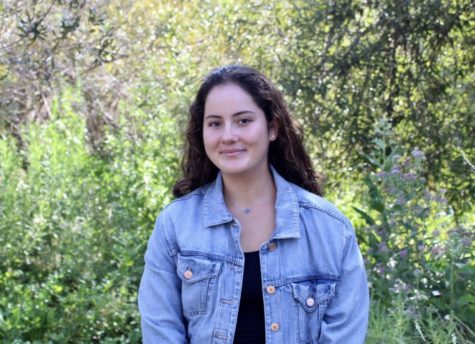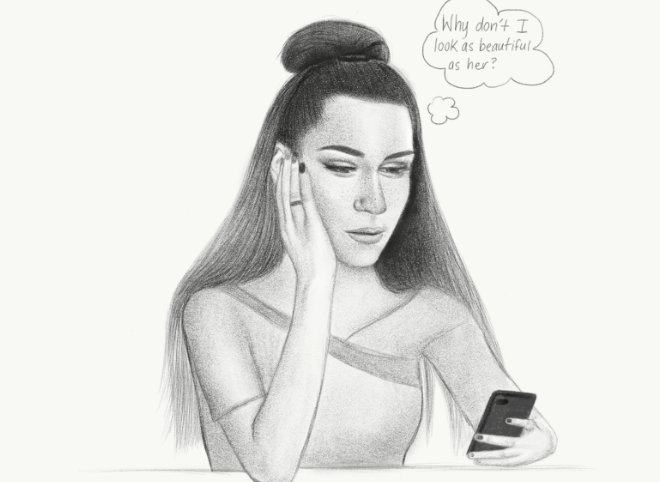Stressful media
Stress caused by social media is rampant among today’s youth, with large percentages of students claiming to have experienced anxiety and stressed by the use of social media platforms.
Cathedral Catholic High School student Emily Gonzales ‘19, an avid user of social media, spends approximately three hours each day on various social media platforms such as Instagram and Twitter.
Because of her social media use, Gonzales is no stranger to the stress it can cause.
“When I go on Instagram and Twitter and I see all the current events that are being shared, like bomb threats and the awful things going on in the world, I just feel so anxious and helpless,” Gonzales said. “There’s all these bad things that are going on, and I feel like I’m going to be affected because of it.”
Social media, an essential part of 21st century life, is a place where many people see the news, view pictures of their friends and families, and experience an efficient and quick way to communicate. However, there is a less-acknowledged side of social media use.
“The average person spends around four hours on social media,” CCHS psychology teacher Mr. Francis Caro said. “That’s more than half the school day. Four hours a day of anything will affect how you feel.
“We know that the more time people spend on social media, the less happiness they report.”
According to Mr. Caro, the way that social media harms the minds of young people stretches far beyond the superficial. The teenage brain is much more malleable than the adult brain, which means that problems caused by social media developed in teenage years can continue well into adulthood.
Gonzales’ stress, caused by seeing news on social media, is not anything out of the ordinary. The stress stems from having a distrusting view of the government, Mr. Caro said.
However, the cause of stress from social media stretches far beyond current events. Gonzales, who spends around three hours a day on social media, says that seeing celebrities and models doing “amazing” things causes her self-esteem to drop.
“I see famous people who look so perfect, and they go to all these cool places,” Gonzales said. “It just makes me feel sort of inferior. If they’re doing all these cool things, why aren’t I? Why don’t I look like that?”
CCHS student Alivia Lomax ‘21 also experiences stress caused by seeing the posts of celebrities and models.
“Sometimes, when I look at certain influencers or Youtubers, I think ‘their life is so cool. They live alone, and they’re teenagers,’” Lomax said. “I get really jealous. They are just so beautiful, and I don’t understand why I don’t look like that.”
Lomax’s experience originates in part from seeing other spending time together without her.
“When we were younger and someone wasn’t invited to something, it wasn’t a big deal,” Lomax said. “We just wouldn’t tell them and there were no feelings hurt. But now, with Snapchat and Instagram, it’s all kind of unavoidable. And I feel like people can get really jealous because of it.”
Gonzales also experiences similar stress from not being included in plans.
“I have people, my friends, personally sending me Snapchats of them hanging out together,” Gonzales said. “It just adds on to the stress and the thoughts of ‘why am I not there?’”
Unsurprisingly, Lomax and Gonzales are not alone in their struggles.
In a recent El Cid survey of about 313 CCHS students, 94% students reported using a social media platform, such as Instagram, a photo sharing service, and Snapchat, an application where users can send disappearing picture.
Approximately 56.9% of students have experienced stress or anxiety caused by the use of social media platforms, with most having moderate amounts of stress, and 35.1% of students have temporarily disabled accounts due to stress, with nine percent permanently deleting their accounts due to stress.
Also, 39.6% of students have considered deleting their accounts due to stress, and later decided not to, 24.6% of students have deleted accounts and remade one, and 44.1% of students feel that seeing celebrities on social media impact their self esteem.
Stress can also be indirectly caused by the use of social media, when students’ use of social media takes time away from more important activities like school or relationships.
“I mainly use Youtube as a social media platform, and I feel like most of my stress comes from having to consistently upload videos,” CCHS student Noah Orona ‘21 said. “If I don’t upload consistently, then people won’t see my videos.
“Sometimes I find myself in a room for two hours a day, almost, trying to figure out what to do for one video, compared to only spending thirty minutes on it, and then going on to do something else.”
Orona’s main Youtube channel, TimeTraveler65, is a gaming channel, but he also has a side music channel that demands attention.
Orona also claims that, since he began using social media, it has taken over as one of his main focuses.
“When I’m talking to people, face to face, I find that my attention drifts to my social media,” Orona said. “Like, when am I going to post? When will I make my next video?”
While being on social media constantly causes stress, taking breaks and going on social media infrequently can help alleviate some stress without completely disconnecting from the digital community.
CCHS student William Banning ‘22, a user of both Instagram and Snapchat, says that he rarely feels any stress caused by social media.
“I go on Snapchat once a day, at night, to send streaks and to just talk to my friends,” Banning said. “I usually only go on Instagram to look at memes.”
Streaks are a feature on the app Snapchat that tracks how how many days in a row two users communicate by using pictures.
Like Banning, CCHS student Katherine Stevenson ‘19 has taken a step back from social media usage.
“I used to spend around three hours a day on social media,” Stevenson said. “When I realized how much time I was spending on social media and not doing homework, I knew it needed to change.”
Stevenson recently set her screen time limit for social media to one hour a day, in order to avoid spending too much time mindlessly scrolling through Instagram.
“Setting a screen time limit has definitely helped me be more productive in schoolwork and even relationships,” Stevenson said.
Banning has also noted that not spending too much time on social media has positive side effects.
“I don’t really get stressed out by social media,” Banning said. “I don’t really have anything to be stressed out about. I just look at memes, and they’re funny.
“I don’t really feel bad about myself or get stressed because I don’t see anything that stresses me out.”
But what makes social media so appealing to people, especially young people?
“Well, to start, it’s a way to share pictures and thoughts, as well as to communicate with friends and family,” Mr. Caro said. “You see older people using social media as a way to see what their families are up to, and to stay connected. However, the way that young people use social media is what’s becoming harmful.”
Even though the dangers of social media are well-known throughout the world, Mr. Caro explains why people continue to come back to it.
“Whenever we do something that makes us feel good, we trigger a dopamine release in our brain,” Mr. Caro said. “Dopamine is the brain’s way of rewarding itself. For example, if I were to post something on instagram and it got two hundred likes, which is way more than my normal like average, I would instantly get this feeling of fulfillment. But if the next time I post something, I only get fifty likes, it makes the end result unexpected.
“That’s why so many people continue to use and come back to social media.”
For teenagers, girls especially, the rise of social media has brought a rise in eating disorders as well, Mr. Caro said.
Social media is much more prevalent in modern society than magazines and movies, which is where most eating disorders and body dysphoria came from in the 80s and 90s until the early 2000s. The accessibility of social media, according to Mr. Caro, makes the harm of young girls potentially developing eating disorders such anorexia nervosa or bulimia nervosa much more likely.
“On social media, most people who follow models and actresses are typically teenage girls,” Mr. Caro said. “This image that they see, of the so-called ‘perfect’ woman, enforces a very narrow definition of beauty. They think that they can only be appealing to men if they are as think as the models.
“But the thing is, there is nothing appealing about anorexia.”
Mr. Caro stresses the importance of not letting social media posts and stories affect young people too much.
“You can’t forget that these are manicured photos,” Mr. Caro said. “These people will spend hours looking for a perfect angle, editing the picture to their liking, and even then, it’s still a selected high point in their life. But when we see these pictures, we assume that their entire life is just high points, like going to foreign countries and spending days living like a celebrity.
“We forget these people also have low points, and that a selected picture is just that: a specially chosen picture to show off a high point in life.”

As the Social Media Editor for El Cid this year, I aspire to use my position to help the newspaper reach more students than ever. While writing for the...






















































